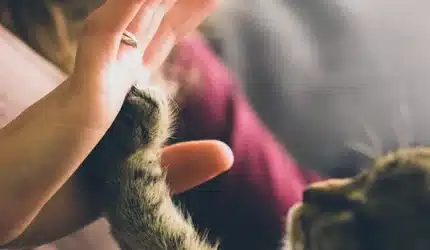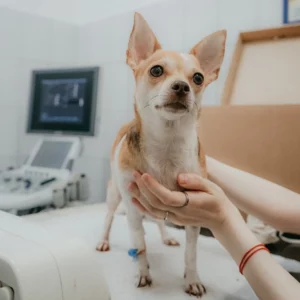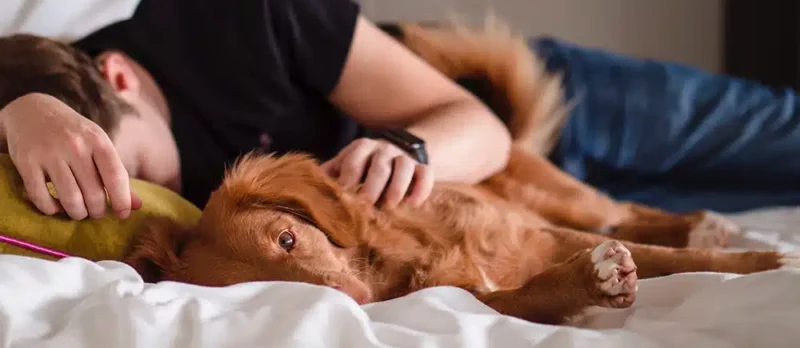Moving with pets doesn’t have to be RUFF.
Even though it can be stressful for both you and your pets, with careful planning and attention to their needs, you can help them sit, stay, and adjust to their new home smoothly and comfortably.
can help them sit, stay, and adjust to their new home smoothly and comfortably.
1. Get your pet accustomed to packing supplies and boxes
Many pets love to play with packing supplies… who doesn’t enjoy the endless fun of an empty box, bubble wrap, or some tissue paper? To help your pets get used to having boxes around, start packing early.
If you have room, start stocking up on boxes several weeks before your move. Place less commonly used items in the boxes and leave them open. Your pets might be curious at first, but soon they won’t give them a second glance.
Conditioning your pets ahead of time helps reduce disruptions and box attacks as you get closer to moving day and packing begins in earnest.
2. Avoid changing your routine to reduce stress on your pet
Pets (especially dogs and cats) are creatures of habit. The more your schedule changes, the higher their anxiety is likely to go.
It can be tempting to skip the everyday routines with your pets if you’re on a roll with packing or organizing your to-do list, but the small disruption to your flow now will pay off with a happier pet in the long run.
To keep your pet’s stress levels down in the weeks leading up to moving (and on moving day itself if you can!), make sure you:
-
- Feed them at the same times as usual
- Never skip their regular walks or playtime
3. Give them a little extra love and patience
Moving is stressful for them too! Keep your pets entertained.
You’re going to be busy while you’re moving, but making a little extra time to entertain and exercise your pets is essential. One of the best antidotes to stress is burning off all that anxious energy! A tired pet is a calm pet, which will make your whole move more peaceful for everyone.
If things are just too busy to fit in an extra walk or play session, consider asking a friend to come help and take your furry friend for some outdoor playdates. Dog walking services are also a great way to help your pup get some exercise and time away from a hectic household. Check out an app like Rover or Wag to find a reliable dog walker in your area.
Consider using brain games as an additional way to help keep your pet occupied. They will be less likely to get bored and misbehave, and it will free up time for you to focus on other tasks.
FREE Pet-Friendly Checklist
Moving With Pets
MUST-DO STEPS for a HAPPY MOVE
Moving with Pets doesn’t have to be ruff. Prepare for the big day with our FREE Pet-Friendly Moving With Pets Checklist
When You’re Buying * When You’re Selling * If Your Pet Gets Lost
Moving With Pets Checklist
Where should we send your FREE Checklist?
4. Keep a comfortable, secluded space for your pet
Boxes, piles of clothes, half-taken apart furniture… moving can quickly turn your once-organized home into a mountain of clutter. While some mess is unavoidable, keeping at least one space clear and comfortable for your pet throughout the moving process is a necessity for a happy pet.
Whether that’s a small room, corner, or even an open closet, having somewhere they can retreat to when the chaos overwhelms them is key, especially for cats and dogs.
It can be ideal to have a friend, family member, or trusted kennel keep your pet for a couple of days as you make the actual move, but sometimes that doesn’t work.
If your pets are along for the move, prioritize getting your pet’s space ready first when you arrive at your new place. Place their blanket, cage, or crate in a comfortable spot that’s away from the hustle and bustle of the move, but not so far that they can’t hear you. You don’t want them to feel like they’ve been left alone in a brand-new place.
Consider putting dogs and cats in a room with a door that can be closed during move-out and move-in, as the front door is likely going to be open a lot as you move all your things inside. The last thing you want is an escapee to chase after during your already exhausting day.
5. Get in touch with your vet
Vets know a lot about helping pets manage stressful situations… especially since most pets don’t enjoy their visits! They are an excellent resource for questions about reducing your pet’s anxiety levels.
visits! They are an excellent resource for questions about reducing your pet’s anxiety levels.
It’s a good idea to book a visit with your vet a few weeks before you move so you can do the following:
Double-check that all vaccinations are up to date and obtain a current rabies vaccination certificate (if needed).
Make sure your pet is healthy and stocked up on any regular prescriptions so that you are less likely to have to make an emergency visit during your busiest time.
Chat about potential stress-reduction tactics or supplements to help ease anxiety.
Request a copy of your pet’s medical files and records if you are moving away from your current neighborhood or city and will need to switch vets.
Ask your vet for a recommendation for a new vet if you haven’t found one in your new community yet.
Ask about additional tests or vaccinations if moving out of state.
Download Your FREE Moving Checklist
6. Inform yourself of new pet laws if you’re moving to a new city
You don’t want to be caught off guard by the leash and pet laws if you move to a new city!
Do your research beforehand, so you know what to expect. If you’re moving into a new apartment (or rental home), it’s important to know the pet requirements for your lease. The last thing you want is to be turned away when you show up with a pet!
It is a good idea to have newly updated pet tags made before you move. If your pet is microchipped, don’t forget to update their information online.
7. If you’re moving with pets across the state, make sure you plan pet-friendly accommodations
When booking your accommodations, make sure your pet will be welcome wherever you are staying. Many popular booking websites let you narrow your search to only include those places that are pet-friendly, but don’t assume all pets will be welcome!
Check with the accommodation provider if you are moving with a venomous snake or a pet that is a bit out of the ordinary.
8. Secure your pet and make sure they stay close to keep them safe
During the moving process, doors will be left open, and people will be going in and out. Keep your pet secure so they have no opportunities to run away due to fear or confusion. Place them in a kennel in a quiet part of the house or a separate closed room.
Do not leave your dog unattended in the backyard of your new home while moving in! Have a current photo and updated tags/microchips just in case they escape.
9. Pack a separate emergency moving bag for your pet
Reduce the stress of moving for both yourself and your pet by having all your pet’s necessities packed and on  hand. Water bowls, favorite toys, a blanket, food, treats, kitty litter, etc., are a good start.
hand. Water bowls, favorite toys, a blanket, food, treats, kitty litter, etc., are a good start.
Don’t forget a roll of paper towels and disposable plastic bags to help with unexpected clean-ups!
10. Prepare your pet for a safe move in your vehicle
The best place for your pet is secured by a seatbelt in their crate or carrier in the backseat. Make sure seat belts are securely fastened in case of an accident and that there are no loose objects or boxes that could fall and hit your pet. You can put a blanket over your pet’s crate or carrier to reduce visual stimulation if you think this will help reduce their anxiety (a definite must for our bird friends).
It is important to remember that this should not be the first time your pet has been in their crate or carrier! Familiarize them with it beforehand, so it is a safe and comfortable travel space. You can even take them out on a few test drives beforehand, so travelling in the car is not a new and scary experience.
11. Pet-proof your new home before your pet arrive
A new space can mean unexpected hazards for your pet. Follow these pet-proofing tips to make sure they will be safe in their new home:
- Secure all screens, windows, gates, and doors
- If you have a balcony, ensure your pet cannot squeeze through or jump over the railing

- Scour outdoor fences for potential escape routes
- Make sure all vents have covers
- Close toilet lids so small pets cannot fall in, and dogs cannot drink water that may contain chemicals
- Check for any pest control traps or poison that may be from the previous owner.
- Plants can also be poisonous, so check the backyard and remove or isolate any plants that present a threat to your pet
- Don’t just look for the obvious! Mothballs, fire starter sticks, and electrical cords are just a few things that can harm your pet
- Keep in mind that dogs are prone to chewing when they feel anxious. Be proactive and provide them with plenty of chew toys so they will not be tempted to chew on less desirable options (your shoes or an electrical cord for example).
Try your best to keep your space clean and clutter-free to reduce the chances your pet will get into something that could harm them.
12. Adjusting Your Pet To Your New Home
A new home is a stressful adjustment for most animals, but there are a few things you can do to make the transition easier.
Introduce your pet to their new space slowly. On arrival, keep them secluded to a single part of the house and make sure they have all their everyday necessities nearby.
For cat owners, you will be able to relocate their cat litter to a more permanent location once they are more comfortable with their surroundings. Do not be in a rush to replace any of their old toys, beds or water dishes. The more familiar objects they have the better.
When you arrive, try and walk your dog throughout your new home (or apartment) and give them ample time to sniff the new smells and get used to their new surroundings. Give your cat space to hide out in a dark place until they feel safe.
Most importantly, keep to a routine as much as possible to help your pet get back to normal. The quicker you bounce back to your normal routine, the faster your pet will begin to feel at home.
13. Stay home as much as possible
For the first week to help reassure your pet that everything is fine. If you have to step out, make sure you do notleave your dog alone in the backyard during the adjustment period. Dogs go to great lengths in search of familiar surroundings, so their chances of escape increase as they search. Play it safe and keep a close eye on them until they are more familiar with their new surroundings.
Lastly, give your pet a lot of positive attention and interactions. This is the time to spoil them with extra affection and treats! Help make positive associates with your new space by hiding treats for them to find, and use brain games to keep their minds busy and relaxed.
How long will it take for my pet to adjust to our new home?
Although you might be eager for your pet to settle in to their new space, expect a period of adjustment, and you might see some strange behavior.
- Your cat might disappear for a few days or forget to use the litter box.
- Dogs may have some accidents in the house, and you may notice your pet has little to no appetite.
Be patient and know that this is normal and not permanent. Once your pet has had time to realize they are in a safe place, they will go back to being their usual selves.
However, if your pet is still showing signs of anxiety or unusual behaviour after a month, it might be time to check with their vet.
Moving with Pets Resources
Everyone will agree that one of the best-known pet advocates is Cesar Millan – and here’s what he has posted on his website.
Another helpful resource to get you started on the right paw, minimize everyone’s stress on moving day, and also help reduce the risk of pet escape – Here’s your Checklist:
FREE Pet-Friendly Checklist
Moving With Pets
MUST-DO STEPS for a HAPPY MOVE
Moving with Pets doesn’t have to be ruff. Prepare for the big day with our FREE Pet-Friendly Moving With Pets Checklist
When You’re Buying * When You’re Selling * If Your Pet Gets Lost
Moving With Pets Checklist
Where should we send your FREE Checklist?
Tips On Moving With Different Types Of Pets
We’ve included specific tips on moving with different pets here… the majority of our tips above work with dogs and cats, but we wanted to include some additional tips on moving with other kinds of pets.
Moving With Fish
Moves can be stressful and sometimes fatal for fish, so plan carefully. If you are only moving a small number of fish, you can transport them in plastic bags half and half-filled with water and air. You can move a larger number of fish using 5-10 gallon plastic containers. Portable aerators are a good idea if your move will take a few days.
Moving With Guinea Pigs, Hamsters, or Mice
Keep your small friends in their usual cages or containers. Make sure they are secure in your vehicle and that nothing will bump into them or knock them over. Covering the cage is an excellent way to reduce stimulation and regulate temperature.
Moving With Birds
If you have birds you may think you can wholeheartedly trust they won’t fly away from you, but while the stresses of moving are high, it’s dangerous to leave it up to trust! Moving can make birds incredibly anxious, so the safest place for them is in their cage. Getting them safely to their new home will be worth it.
Birds are susceptible to temperature changes, so it is a good idea to cover their cage to block out any unwelcome drafts. This will also help keep them calm! To keep them as comfortable as possible, make sure they have plenty of water, a place to perch, and their favorite snack.
If moving to a new state, your bird may need a health certificate or additional tests. Make sure you are familiar with the laws and regulations ahead of time.
Moving With Reptiles
Your reptile buddy needs surroundings that are moist but not wet. Putting a damp cloth in their container is a good way to keep them safe and happy.
You should move snakes in a well-insulated container with a lot of air holes. Double up for venomous snakes by transporting them in two sturdy boxes or a box inside a wooden crate.
Turtles are easy to move. Did you know you can even overnight express mail your turtle? Check out The Mid-Atlantic Turtle and Tortoise Society for instructions. Otherwise, transport in an insulated box with plenty of air holes.
Whatever kind of reptile you are taking with you, mark the outside of the container with the name and species, and make yourself aware of any government regulations regarding your pet.
Download Your Moving Checklist (you can fill-in-the-blanks)

Questions? Ask Us Anything!
Let's Connect
Tell us what's on your mind - we'll get right back to you.

